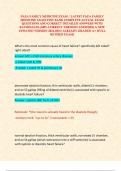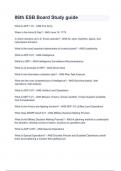PAEA FAMILY MEDICINE EXAM / LATEST PAEA FAMILY
MEDICINE EXAM TEST BANK COMPLETE ACTUAL EXAM
QUESTIONS AND CORRECT DETAILED ANSWERS WITH
RATIONALES (100% CORRECT VERIFIED ANSWERS) A NEW
UPDATED VERSION 2024-2025|ALREADY GRADED A+ (FULL
REVISED EXAM)
What is the most common cause of heart failure? specifically left sided?
right sided?
answer-MC is CAD (coronary artery disease)
-L sided: CAD & HTN
-R sided: L sided HF & pulmonary dz
decreased ejection fraction, thin ventricular walls, dilated LV chamber,
and an S3 gallop (filling of dilated ventricle) is associated with systolic or
diastolic heart failure?
Answer- systolic (MC form of CHF)
Rationale: *(the sound is actually heard in the diastole though)
-memory trick: "sys-to-lic" 3 consonants = S3
normal ejection fraction, thick ventricular walls, narrowed LV chamber,
and an S4 gallop (atrial contraction into a stiff ventricle) is associated
with systolic or diastolic heart failure?
,Answer- diastolic
Rationale: -memory trick: "di-a-sto-lic" 4 consonants = S4
what are the causes of systolic vs diastolic heart failure?
Answer- -systolic: post MI, dilated cardiomyopathy, myocarditis
-diastolic: HTN, LVH, elderly, valvular heart dz, hypertrophic or
restrictive cardiomyopathy, constrictive pericarditis
when the metabolic demands of the body exceed normal cardiac
function (d/t thyrotoxicosis, wet beriberi, severe anemia, AV shunting,
Paget's disease of the bone) this is termed ________ heart failure
high-output
*fairly uncommon
-low-output HF is just d/t problem w/ myocardial contraction, ischemia,
or chronic HTN
what are some causes of acute vs chronic heart failure?
,-acute: largely systolic; hypertensive crisis, acute MI, papillary muscle
rupture
-chronic: dilated cardiomyopathy (systolic), valvular dz (diastolic)
explain class I-IV New York Heart Association functional classes
-class I: no sx's, no limitation during ordinary physical activity
-class II: mild sx's (dyspnea or angina), slight limitation during ordinary
activity
-class III: comfortable only at rest (sx's caused maked limitation in
activity even with minimal exertion
-class IV: sx's even while at rest, severe limitations, inability to carry out
physical activity
what compensations does the body make when heart failure (can be
due to something that causes either inc pre/afterload or dec
contractility) begins?
1. sympathetic nervous system activation
2. myocyte hypertrophy/remodeling
3. RAAS activation: fluid overload
the following are signs/sx's of what sided heart failure?
, inc pulmonary venous pressure, dyspnea, orthopnea, rales/rhonchi,
chronic non-productive cough with pink frothy sputum, HTN, Cheyne-
Stokes breathing, S3 or S4, pale skin/cool extremities, sinus tachy,
fatigue
L-sided HF
the following are signs/sx's of what sided heart failure?
inc systemic venous pressure, peripheral edema, JVD, anorexia, N/V,
hepatosplenomegaly, RUQ tenderness, hepatojugular reflex (inc JVP
with liver palpation)
R-sided HF
-CXR showing Kerley B lines (alternate flow tracts), cardiomegaly,
pleural effusion, pulmonary edema
-echo with dec EF
-inc BNP on labs
are all signs of?
heart failure
*BNP released from atrium with preload too high (volume overload)





